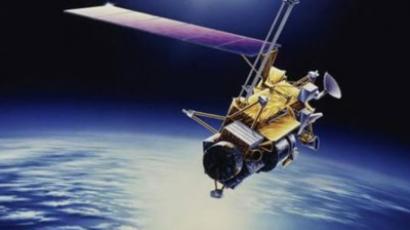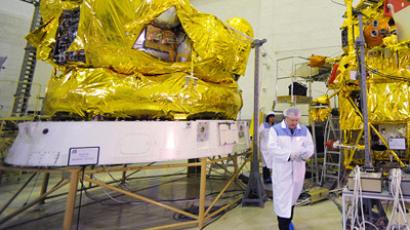Martian curse: Russian probe may crash in populated area
Russian scientists are struggling to get the country's first interplanetary mission in 15 years back on track. Should they fail, the probe that was due to head to the Martian moon Phobos may well turn into the “most toxic falling satellite ever.”
Following a successful launch from Russia’s Baikonur Cosmodrome in Kazakhstan and the subsequent separation of the Phobos-Grunt probe from its booster rocket on Wednesday morning, its own engine failed to generate two impulses which were necessary to direct the spacecraft onto a path to Mars. As a consequence, the probe became stuck in a low transitory orbit above Earth.Before scientists from Russia’s space agency Roscosmos could solve the problem and “reboot” the mission, they would have to find out what exactly has caused the failure. Some say a problem with the probe’s software is the likely culprit, while others speculate that the worst-case scenario – a problem with the hardware – is also possible.Most issues with the software could potentially be fixed remotely. One of the theories put forward suggests that a problem could have occurred with the navigation system. When launched, spacecraft initially use the sun as the main reference point for navigation, switching later to the stars. Therefore, it is thought the probe could have failed to position itself relative to the constellations.Should that be the case, specialists say, they could try to upload a software package to the probe, and if everything goes fine, the entire mission could still be put back on track, with a minor delay of a few days.If the problem turns out to be a hardware failure, the consequences could potentially be disastrous, and not for the space mission alone…
‘Most toxic falling satellite’
The Phobos-Grunt probe is loaded with seven tons of highly toxic fuel, which was supposed to propel the spacecraft at various stages of this lengthy and complex mission. For this reason, the probe has already been dubbed as “the most toxic falling satellite ever.”Therefore, if Russian specialists fail to determine and fix the issue and the spacecraft eventually falls to Earth, they may have to come up with a contingency plan to deal with the potential hazard to large areas. At the same time, experts say they still have plenty of time to develop an effective plan of action even in this worst-case scenario, to ensure that the falling craft and its toxic fuel pose no threat to people or the environment.It is almost impossible to predict the exact area where the spacecraft might fall, but scientists say it could be anywhere between 52 degrees North and 52 degrees South – an enormous territory. Yet this is exactly where our planet’s most-densely populated areas are located.
‘Launched untested’
As the space drama unfolds, more people have stepped in to rebuke Russia’s space authorities, blaming them for subjecting the probe’s systems to insufficient pre-launch testing.Russian space expert and editor Igor Lisov told Russian News Service radio that the Phobos-Grunt has become one of the most ambitious and costly space projects of recent years, with some 5 billion roubles (approximately US $160 million) pledged to its completion. Eventually, the program ran out both of time and money.“We are trying to overreach ourselves. If you heard what Popovkin (the head of Roscosmos) said in his speech in the State Duma on October 7, he was rather blunt in saying that the spacecraft was being launched under-tested and incomplete,” he said. “In other words, we took a risk.”Other independent specialists agree, saying that the team behind the project had only two years to test the probe’s automated systems, which was not enough. This was the main reason why the initial date for the launch was postponed from 2009 to 2011.
ESA to join rescue efforts
Meanwhile, specialists at Roscosmos have been trying to re-establish connection with the probe. The next attempt is scheduled for Thursday night or Friday morning, Itar-Tass reports.The European Space Agency announced plans on Thursday to join their Russian colleagues in their attempts to revive the mission. The ESA is going to involve two of its telemetric facilities – in French Guiana (South America) and in Australia.“We remain in constant contact with our Russian colleagues and are discussing what help they may require,” Interfax quoted the head of the ESA office in Moscow, Rene Pichel, as saying. “If we succeed in obtaining telemetric information from the spacecraft we will pass it [to the Russian side].”Scientists remain optimistic. With every circuit of Earth, Phobos-Grunt descends by two kilometers, which is much slower than initially predicted. In other words, the team of experts now has more time to diagnose and solve the problem.
Aims and goals
The Phobos-Grunt probe was designed to analyze the surface of Mars’s biggest moon, Phobos, and bring 100-200 grams of its soil back to Earth. It weighs over 13,000 kilos, but only seven kilos placed on the top of the return rocket are to make it back to Earth.The spacecraft will also carry various terrestrial microorganisms, which Russian and US scientists are sending in a capsule on the three-year round trip in order to test their ability to survive in the harsh conditions of open space with its high levels of radiation.Also on board is China’s first Mars satellite, which is to be put in observation orbit around the Red Planet.














